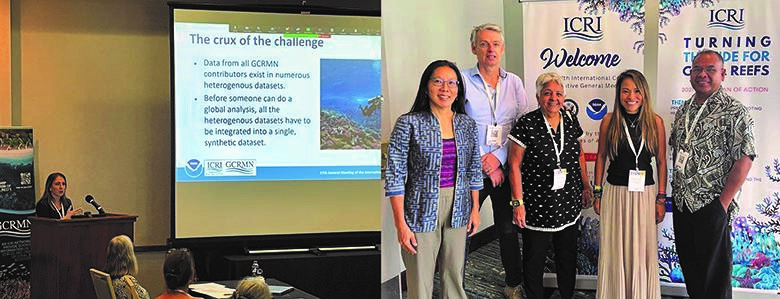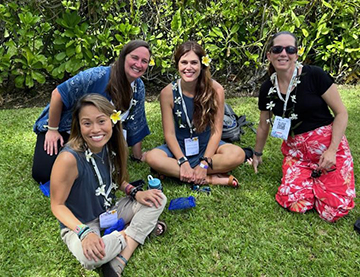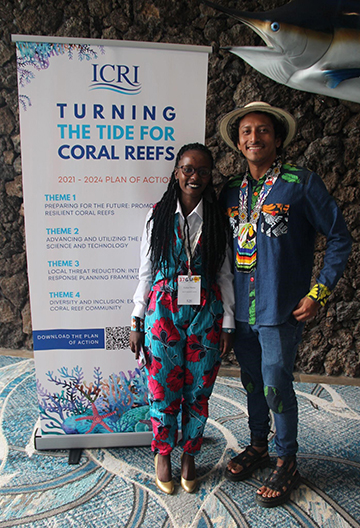- ABOUT US
- PROGRAM AREAS
- CONSERVATION APPROACH
- EDUCATION
- MULTIMEDIA
- Six new members welcomed to ICRI,
- Launch of the Coral Reef Breakthrough,
- Adoption of the resolution on the Coral Reef Breakthrough,
- Adoption of the Resolution on integrating coral reefs into National Biodiversity Strategies and Action Plans,
- Extension of the ad-hoc committee on reef restoration and adaptation, including adoption of a new terms of reference, and,
- Inclusion of Indigenous peoples, traditional owners and youth, and launch of efforts to expand Indigenous and Local Knowledge in ICRI efforts.
International meeting brings global leaders together to address coral reef conservation
By: Erica K. Towle, Global Coral Reef Monitoring Network Data Task Force Co-Chair
Takeaway: The United States hosted the 37th General Meeting of the International Coral Reef Initiative (ICRI) from September 18th-23rd, 2023 in Kailua-Kona, Hawai’i. ICRI is a global partnership working to preserve and protect coral reefs. The key goals of the meeting were to discuss the achievements of ICRI and its members, share knowledge and experiences, and drive the implementation of the 2021 – 2024 Plan of Action: Turning the Tide for Coral Reefs.
The U.S. is the current chair of the International Coral Reef Initiative, and the chair is shared between NOAA Coral Reef Conservation Program (CRCP) and the U.S. Department of State. NOAA CRCP staff played a large role in planning the meeting with the ICRI secretariat.
Global Coral Reef Monitoring Network Steering Committee Meeting
The Global Coral Reef Monitoring Network (GCRMN) is an operational network of ICRI, and convened its Steering Committee for a two-day meeting at the beginning of the week of the ICRI general meeting. The GCRMN is a global network of scientists, managers, and organizations that monitor the condition of coral reefs throughout the world, operating through 10 regional nodes. GCRMN aims to provide the best available scientific information on the status and trends of coral reef ecosystems for their conservation and management. The major goal of the GCRMN two-day steering committee in Kona was to reflect on lessons learned from the GCRMN 2020 global report, and brainstorm how to improve future global reports. A hallmark of the steering committee meeting was discussions on the recently formed GCRMN Data Task Force, which seeks to increase the transparency, reproducibility, and robustness of future GCRMN reports. Another hallmark was having some of the regional coordinators of the The Global Socioeconomic Monitoring Initiative for Coastal Management (SocMon) present, as the GCRMN is looking to increase the inclusion of SocMon data to accompany biophysical data in future global reports.

Welcoming ceremony and Indigenous and local knowledge listening session

The General Meeting started on Tuesday with a listening session about the importance of indigenous and local knowledge, values, and traditions in coral reef conservation. The panel was moderated by 'Aulani Wilhelm, a Kanaka ‘Ōiwi, born and raised in the Hawaiian Islands, who recently completed a term at the White House Office of Science and Technology Policy and is now Nia Tero’s Chief Strategy and External Affairs Officer and Dr. Kyle Whyte, an enrolled member of the Citizen Potawatomi Nation, a U.S. Department of State Science Envoy, and Professor of Environment and Sustainability & George Willis Pack Professor at the University of Michigan. Kumu Keala Ching led an oli before the official meeting proceedings began. In Hawaiian culture, an oli is a chant or a song-like way to respect and appreciate the spirits of the ancestors, and celebrate the sacredness and beauty of the water, mountains, and land. Olis preserve information for posterity to come, and play an important role in helping younger generations connect and understand their Hawaiian ancestry. The oli helped ICRI members hone their sense of place and encouraged us to think about the spiritual connection we have to coral reefs.
In the afternoon of the first day, learning about Hawaiian culture expanded with a visit to Kaloko-Honokōohau National Historical. The park is significant because it preserves nearly intact sites associated with traditional native Hawaiians dating from prehistoric times to historic times. The Hawaiian people of this ancient settlement harvested fish from the sea and from fishponds they constructed. Since a major theme of the meeting was incorporating traditional ecological knowledge into our modern coral reef management, this was an incredible way to learn about traditional native Hawaiian ecological management practices.
Actionable science

The sessions over the rest of the meeting days were characterized by significant progress in taking action for coral reefs and identifying next steps. One example was the adoption of the motion to launch the Coral Reef Breakthrough. The Coral Reef Breakthrough is an initiative to align the coral reef community under two global targets and action points for the conservation, protection, and restoration of coral reefs, in partnership with the Global Fund for Coral Reefs and the High-Level Climate Champions. The Breakthrough aims to secure the future of at least 125,000 square kilometers of shallow-water tropical coral reefs with investments of at least US$12 billion to support the resilience of more than half a billion people globally by 2030. This represents an ambitious and critical movement to prevent the extinction of one of the world’s most threatened, yet most valuable and most biodiverse ecosystems.
Additional highlights of the meeting were two distinct panels that generated rich discussions. The first was a panel about coral reef response plans. The panelists shared their perspectives on responding to threats like Stony Coral Tissue Loss Disease, invasive lionfish, El Niño marine heatwaves, and bleaching. Many panelists highlighted the need for an adaptive management framework to maximize lessons learned, which lead to better management outcomes. The last panel of the meeting was a youth panel, which included panelists under the age of 35. The panel shared fresh perspectives on how the coral reef community can better engage young people and to ensure that early career scientists, managers, and policy makers have a seat at the ICRI table.
Kumu Keala Ching closed the meeting by leading ICRI members with a oli near a restored version of Ahu'ena Heiau, Hawaiian religious temple that served Kamehameha the Great.

Overall, the meeting was a resounding success. Significant meeting outcomes included:
The U.S. team returned from Kona feeling grateful for the opportunity to collaborate with ICRI members and advance ICRI’s Plan of Action. The U.S. has one more year as the chair of ICRI, and we look forward to building upon the momentum we began in Hawai'i.
Related Stories and Products
About Us

The NOAA Coral Reef Conservation Program was established in 2000 by the Coral Reef Conservation Act. Headquartered in Silver Spring, Maryland, the program is part of NOAA's Office for Coastal Management.

The Coral Reef Information System (CoRIS) is the program's information portal that provides access to NOAA coral reef data and products.
Work With US
U.S. Coral Reef Task Force
Funding Opportunities
Employment
Fellowship Program
Contracting Assistance
Graphic Identifier
Featured Stories Archive

Access the archive of featured stories here...
Feedback
Thank you for visiting NOAA’s Coral Reef Conservation Program online. Please take our website satisfaction survey. We welcome your ideas, comments, and feedback. Questions? Email coralreef@noaa.gov.
Stay Connected
Contact Us
NOAA’s Coral Reef Conservation Program
SSMC4, 10th Floor
1305 East West Highway
Silver Spring, MD 20910
coralreef@noaa.gov
